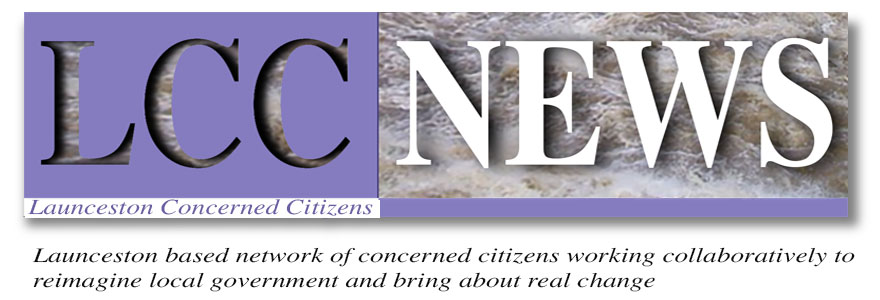Musing around with a basketry workshop going on across town the conversation turned to Launceston’s proposed Cultural Unit. Some assumptions and some scribbling on the back of an envelope suggests that ‘the initiative’ is likely to cost somewhere between $100K & $200K recurrently – possibly more in time.
Despite Launceston Council’s cargo cult mentality, money just doesn’t drop in like a food drop in a crisis zone – say in New Guinea during WW2. The cost here is to Launceston’s ratepayers as we’ve come to learn that when money does drop in … it’s a loan that’s to be paid back.
First up, there are some assumptions here relative to the Cultural Unit and under the ‘confidentiality rules’ enshrined in SECTION 62 of the Local Govt. Act Tas 1993 that’s all they can be – assumptions. Nonetheless if you’ve been around the block a few times those numbers – $100K to $200K – feel OK if we are talking about:
• A position for an intelligent person, their salary and on-costs;
• Some part-time or intermittent support;
• Infrastructure and equipment;
• Travel, transport and related costs etc.
Thus far all the indicators seem to be suggesting this. Always remembering that many of these costs are hidden and often go unacknowledged. It is a political imperative.
Recalling the 1970s when there was a flush of Arts Funding and many opportunities were wasted on such initiatives – that’s an opinion. So far as it was politically tolerated direct funding to ‘producers’ delivered impressive ‘key performance indicators’ in quick smart time.
BTW: Direct Funding = Targeted Grant For Target Outcome.
Moving right along, TGTO[Grants] of $20K (Cultural Unit cost $200K) in a year would deliver:
• 10 quite generous cultural projects in the community across say 5 disciplines – performance outcomes, art in public places, touring exhibitions etc;
• Almost unprecedented opportunities to grow ’the cultural sector’ in Launceston or on the Tamar if adjoining Councils could be encouraged to participate in such a program;
• 10 more generous cultural projects in the community IF the grants attracted complementary funding, sponsorships or say PhD, Masters, whatever, scholarships; and
• If some were $10K and one say $30K, perhaps a lot more cultural activity still.
This kind of expenditure would have a direct economic impact in the community IF it was a requirement that the project took place in the community and carried out by someone currently living in the community.
Perhaps, it would be an audacious initiative but Tasmania, with the opening of MONA, has witnessed the fruits of serial audacity being planted.
Such grants are relatively easy to administer, and accountably, on the scale suggested here and they could, ideally should, be devolved to a trustworthy incorporated arts organisations, university, etc with expert peer assessment panels advising them. The important task being to remove the politics from the decision making. There might well be an arms-length trust set up to attract complementary donations and sponsorships.
Anyway, there’s that thinking and it’s “out of the bag” as they say.
Then again, the announcement in Sydney to do with the Powerhouse is as one would expect, political and pragmatic! The lack of a ‘business case’ resonates fairly loudly here in Launceston with UTAS in mind.
Nonetheless, the players on the ground in Sydney seem to be saying that there is more to be played out in all this yet with ex-Premier Baird yet to front up to ‘the inquiry’.
Many of the ‘players’ and protagonists that remain are there as advocates for the status quo despite the evidence telling many of us that the “quo has lost its status” in a 21st Century context.
Interestingly, all the ‘branding’ seems to be projecting that the quo in regard to the Powerhouses’ governance looks like being ‘politically preserved’ (bureaucratically fossilised) rather than renewed.
There are good arguments for renewal in musingplaces and not just at the Powerhouse. The purpose of musingplaces is simultaneously becoming more focused while being opened up to new possibilities and opportunities. It is especially so in the digital environment.
Along with the lack of a business case the press releases (apparently) seem to be saying precious little about the operation’s/institution’s purpose. A purposeful business case looks like as if it might be unlikely.
However, there is a full set of unmeasurable aspirations (aspirational political smoodging) in the full colour, jazzed-up strategic plan that looks every bit like it remains dedicated to the status quo albeit with a new set of clothes [LINK]
In both Launceston and Sydney it looks like it’s a bridge too far to have anything that’s measurable in any kind of credible accountability process. Nonetheless, it is somewhat reassuring that the ‘acknowledgement of country’ is there up front and centre in the Powerhouse’s strategic plan.
\With the numbers being bandied about in NSW, $645 million, it is quite likely that the costs will blow out just as soon as the first sod has been turned. Curiously, accountability is not high on anyone’s agenda albeit that a sense of ‘purposefulness’ almost certainly could deliver and politically even.
It does help to know what you’re there to do and why – a quaint idea it seems.
Ray Norman April 2018










